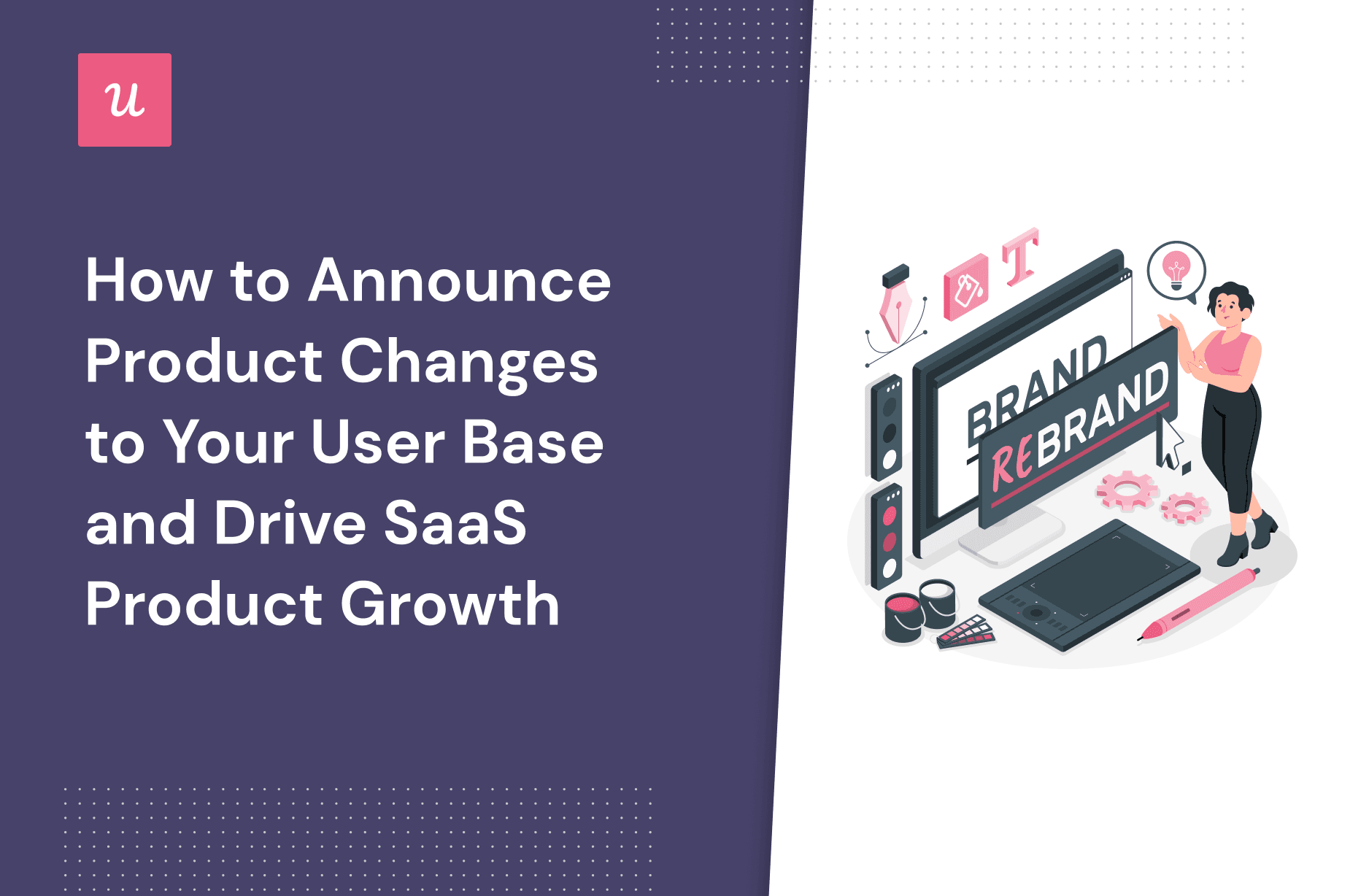
How to Announce Product Changes to Your User Base and Drive SaaS Product Growth
Try Userpilot Now
See Why 1,000+ Teams Choose Userpilot

What are product changes?
Product changes are any alterations made to an existing product. These changes are typically effected to enable companies to serve customers better, stay ahead of the competition, or simply change the direction of the product.
Product changes can take many forms. Common examples include pricing changes, new features, feature deprecations, admin and back-end updates, and rollbacks.
Changes can be minor, like fixing bugs, making virus-related updates, or small product improvements. They can also be significant, like a whole product redesign or drastic changes to company policy and general business direction.
Why should you announce product changes?
Whether minor or major, product updates mean some aspects of your software will disappear or cease to function as usual. This tends to affect the customer’s feelings; hence it’s always a good idea to let them know rather than wait for them to find out for themselves.
Other reasons every customer-centric company must take product announcements seriously:
Drive new feature discovery and adoption
You didn’t spend human and material resources on product changes because you were bored; you expect them to move the needle on KPIs, spark growth, and increase usage.
That won’t happen without announcing changes. Most users already have a fixed routine around your product and won’t notice any new updates due to feature blindness.
With a proper communication strategy, you can get them excited, expose them to new features and drive better adoption and engagement.
Attract new potential users
Announcing product changes on social media or any other public channel will drive brand awareness, but that’s not the only benefit.
Your new feature might be what a prospect needs at that point in their life, and you’ll attract them by just announcing what you’ve rolled out.
In addition, sharing the news of your updates will let existing users know that your product is always growing.
Close the feedback loop and build trust with customers
A good way to close the feedback loop is to let customers know the updates/features they requested have been added successfully.
This will get users happy and make them feel valued. You could even win some of them over as loyal and committed users in the process.
Another advantage of closing the feedback loop is the trust you get to build with customers. They will be more confident in providing quality feedback in the future.
How do you announce a product change?
Now that you’re convinced of the importance of making product change announcements, how do you actually go about it?
Fortunately, there are many different channels at your disposal. And for optimal results, it’s always best to combine multiple channels at once. Let’s go over them:
Announce product changes with in-app notifications
In-app notifications are effective because they’re timely and contextual. Receiving update notifications in-app also means users can start experimenting with your changes immediately.
You can use a range of UI patterns for in-app announcements including modals, slideouts, banners, and tooltips.
You can also create mobile-optimized announcements, extending these powerful communication strategies to your mobile app users.
Here’s how a social media software, Postfity announces the new feature with a slideout once the user has logged into the product for the first time after the update.

Pair in-app notifications with email marketing
The fantastic thing about emails is that they pair easily with any other marketing/comms channel. However, keep in mind that people don’t come to their mailbox looking for the next update from you.
As a matter of fact, asking them to check your app out is an act of interruption because they opened the email for a different purpose.
The best way to capture a user’s attention via email is to keep your copy catchy and valuable.
Emails about product changes are best sent to disengaged users, churned customers, or people on your mailing list who haven’t started using your tool.
Good email copy example from Hootsuite:

Notify your website visitors about product updates
The average SaaS buyer experiences multiple touchpoints before deciding to buy a product.
This means prospects may visit your website many times before converting. The last thing you want to do is wait till they subscribe before shocking them with new updates. This is where website notifications come in.
Two ways to implement it:
- Have a what’s new section on your website;
- Use a notification banner like the one below to communicate with users:

Timely website notifications build trust by ensuring visitors know what they’re getting into before buying your software.
Share the news on social media platforms
Social media is the easiest place to make your updates go viral.
Choose the best platform based on where your customers and prospects congregate the most. Tweak your announcements to fit what works best with the app’s algorithm.
For instance, Slack made its Twitter update short and catchy because it’s Twitter. The text would probably be longer and have images if it’s on LinkedIn or Facebook.

Create a blog post detailing your changes
Social media is a third-party platform, and you generally have to be brief with your posts. Plus, your content can easily get lost in a sea of others.
But you wouldn’t have to deal with these if you have a company blog. Create a detailed blog post explaining the new changes’ meaning for existing and prospective users. You can also link to help docs on your website that demonstrate how users can make the most of your new releases.

Pro tip: create a blog and use social media to drive traffic.
Display your upcoming releases on a public product roadmap
A good public roadmap shows visitors at a glance what your new releases are, ideas you’re working on, and what your product strategy is.
You can go the extra mile to include filters in your roadmap to make them easily searchable. Also, make it possible for visitors to get reminders of when specific releases are made.

Best practices for communicating product changes to your users
Every product update will do one of two things: drive engagement or make customers churn.
Interestingly, the critical factor often isn’t whether the update was good or bad, but how it was communicated. Imagine waking up one day and receiving a notification that the price for your favorite software has increased by 50%. It won’t sit well compared to if you were told beforehand and the company took time to explain the reason for the price hike.
As a SaaS business, you can’t go wrong using the practices below for communicating change:
Communicate changes well in advance and prepare impacted users
The window you should give between announcing a change and actually making it depends on the magnitude of that update.
If it’s not something that will affect users much—e.g., bug fixes or a few hours of downtimes—then you don’t need much early communication.
However, significant changes like feature sunsets or anything highly affecting consistent users should have enough window (weeks or months). This is to give users ample time to prepare.
How to communicate such news? A good approach is to run marketing campaigns weeks before the launch. Your campaigns should focus on how the new version of your product will benefit users and help them to do their jobs faster and better. Campaigns like this will build hype around your tool and excite customers about upcoming changes.
Start with a soft launch and test the beta version of your product
A soft launch allows you to test updates with a small group to know how well others will perceive them.
Knowing it’s a beta test also means users won’t get infuriated if they don’t like the changes. You’ll also gather feedback from them on how to make the update better.
Additionally, your testers will be excited when they see you make improvements to the final release based on their feedback. You could even collect testimonials from them and use them as social proof to increase adoption.

Segment users and personalize product release notes
Chances are your product serves different user segments. If this is true, it also means they won’t all find a general release note valuable.
Use a tool like Userpilot to segment users based on use cases or other factors you consider important. Then, send personalized release notes to each segment, stating how important the update is to them.

You can also create user personas to get more detailed information about your customers.
A good user persona should go into granular details like social media habits, gender, age, specific challenges, goals, etc.

Use visual elements in your messages to drive engagement
Remember that thing about pictures painting a thousand words? It couldn’t be truer in communicating product updates.
Imagine this: you open your email app and see a message from one of the SaaS companies you use. You click it to see what they have to say, and it’s just blocks of text explaining a new release.
You’ll probably read through if the email is short and interesting, but you won’t get a clear picture of how to maximize the change.
Now compare that to a company that uses visual elements like pictures, Gifs, videos, etc., to provide a step-by-step guide on how the new update works. This will get you engaged and help you understand the changes better.
Interactive walkthroughs work best for situations like this. They help the customer familiarize themselves with updates by actually taking action (e.g., following prompts to learn a new feature).
Here’s an example:

Interactive walkthroughs don’t fit into all forms of product changes, so try to use other visual elements when they don’t.
Choose the right UI pattern for announcing your product changes
We’ve mentioned you can use a range of UI patterns for in-app communication. Not let’s discuss the best use case for each.
For minor changes such as subtle user interface updates or a small enhancement to an existing product, it’s best not to interrupt the user experience. Simply use hotspots or tooltips to draw attention subtly.

If it’s a big product update and affects the majority of your customers, use attention-grabbing modals to ensure users don’t miss it.

A/B test in-app product change announcements
Stop guessing and use A/B testing to discover which in-app announcement format, timing, and message works best. Test and iterate, then use the data to make smart choices.

Host a webinar for major product changes
The advantage of webinars is the face-to-face communication they allow, making customers feel more in touch with you. Webinars also provide opportunities for customers to ask questions and get immediate answers.
Customer contributions on webinars can as well provide data for shaping your product or at least give you FAQs to add to your release notes.

Promote big product updates with a Product Hunt launch
With millions of people on the platform, Product Hunt has the capacity to drive thousands of visitors to your updates.
But you have to be strategic. The platform doesn’t allow you a relaunch until after six months and on the condition of a complete redesign of your update. Make your first launch worth it.
You can share the news of your PH launch on social media and with email subscribers to drive more upvotes.

Bonus tip: Bring back churned users with the right product update email
Users sometimes leave your app because of a missing feature. But you’ll never know that’s why they’re going if they don’t tell you.
Use exit surveys like the one below to gather reasons for churn. Then, segment the data and note users who left because of specific features or add-ons they couldn’t find on your app.

Collecting this data and asking the user for permission to contact them in the future can help bring them back. All you have to do is send an email when you’ve rolled out the updates they wanted.
Example:

Gather customer feedback to measure success and close the feedback loop
Send feedback surveys immediately after users have tried your product changes. Include qualitative and quantitative questions to get comprehensive data on how users feel.
This shouldn’t be a one-time process. Routinely collect and analyze feedback to find areas of improvement and enhance the product.

How to announce a product or feature sunset
You’ll often have to sunset a product or feature because they no longer reflect your vision. But customers won’t understand, and there’s a high likelihood many of them will get affected by your action.
So how do you announce a sunset without making it hard for customers?
Some tips:
- Give prior warning(s) and mention a specific termination date to allow them enough preparation time.
- Promote a new product or feature they can use to replace the one you’re removing
- Offer added incentives for using the latest update. E.g., a price slash or some free time on your tool.
- Don’t forget to appreciate them for using the product/feature so far.
Conclusion
Even if your product was perfect from the start, the market, technology, and customer needs would keep changing, and you’ll be forced to make adjustments.
Without the right strategy and proper change management, your efforts won’t yield the desired results. Adoption rates will be low, and in worst cases, customers may even churn.
Hopefully, the methods discussed in this piece have given you a proper roadmap for announcing product changes.
Let Userpilot be your go-to software on this journey. Our platform is equipped to help you drive adoption for minor and major product changes through in-app messages, user segmentation, UI patterns, etc. Book a demo with our team to learn more.








